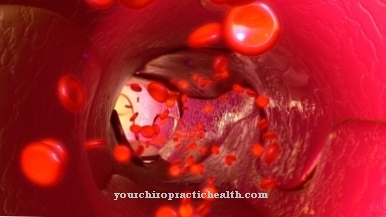The inspiration (inhalation) is a phase of the breathing cycle. During inspiration, fresh and oxygen-rich air enters the lungs, which from there supplies the entire body with vital oxygen.
What is the inspiration?
The inspiration, in German inhalation, is part of the breathing cycle. During inspiration, fresh and oxygen-rich air is drawn into the alveoli of the lungs, causing the lungs to expand.
In contrast to the more passive exhalation, the inhalation is an active process because the respiratory muscles have to tense in order to do the necessary pressure-volume work. When it comes to inspiration, a distinction is made between chest and abdominal breathing.
Function & task

Inspiration (inhalation) is a phase of the breathing cycle. During inspiration, fresh and oxygen-rich air enters the lungs, which from there supplies the entire body with vital oxygen.
The inspiration provides the body with fresh, oxygen-rich air. At the same time, the conditions are created so that the carbon dioxide produced by the body can be exhaled.
The respiratory muscles and auxiliary respiratory muscles must work so that the fresh air can flow in. As a result, the rib cage expands, which can be seen by lifting it up. The lungs follow the movements of the chest due to the pleura, a layer of tissue made up of two sheets between the lungs and the chest, which are strongly attached to each other due to a fluid between them.
Since the lungs are very elastic, they expand together with the chest, creating a negative pressure in the lungs. This allows the inhaled air to flow in through the airways.
The muscles that mainly work during the inspiration phase depend on the type of breath. During chest breathing, the intercostal muscles and the auxiliary breathing muscles are particularly active, which causes the chest to expand and the lungs to make room. In abdominal breathing, on the other hand, the diaphragm does most of the work of breathing. Its contraction allows the lungs to expand downward.
Before the air you breathe reaches the lungs, it passes through the nose or mouth, throat, larynx, windpipe and bronchi. Once the breathing air has reached the lungs, gas exchange takes place in around 300,000 alveoli, also known as the alveoli. This means that the oxygen from the inhaled air is diffused from the alveoli into the blood and at the same time the carbon dioxide from the blood reaches the alveoli. In this way, the carbon dioxide can be removed from the body in the course of expiration, exhalation and thus the second major phase of the breathing cycle.
The oxygen-rich blood supplies all cells of the body with vital oxygen via the human circulation. The respective cells can only continue their metabolic processes with sufficient oxygen. However, not all of the oxygen that is inhaled is used up by the body; a large part is exhaled again. While the inhaled air is enriched with 21 percent oxygen, the exhaled air still has around 17 percent oxygen. For this reason, it is also possible to donate breathing when breathing has stopped, because the exhaled air still contains sufficient oxygen.
The entire process of inspiration is automatically controlled by the breathing center in the elongated spinal cord. However, a perfected breathing technique with conscious inhalation is also possible and leads to better body awareness, which can be important, for example, when making music or in certain sports.
You can find your medication here
➔ Medicines for shortness of breath and lung problemsIllnesses & ailments
Numerous problems can arise with inhalation. Even if these occur only temporarily, complaints during inspiration should always be taken seriously. In some cases the symptoms are psychological.
Some disturbances in inspiration and their consequences can cause serious and far-reaching health problems for the person concerned. The most serious case is acute respiratory arrest, which is fatal after just a few minutes due to the lack of oxygen supply to the cells.
Inhalation disorders are usually noticeable in the form of pain, noise, a change in the breathing rate or the subjective feeling of shortness of breath. Inadvertently inhaled foreign bodies can also hinder inspiration.
The causes of discomfort during inspiration can be just as diverse as their appearance and lie both in the thoracic area and outside. Often the cause of the inhalation problem lies in the upper or lower airways. If these are blocked, this is expressed by a low whistling sound and difficult inhalation. Even with damaged bronchi, for example through bronchitis or asthma, and lung damage, for example as a result of pneumonia, there can be considerable shortness of breath.
The lungs and the heart are closely related. Therefore, heart problems can also lead to problems with inspiration. A general, chronic heart failure or an acute heart attack can lead to pulmonary edema. Fluid can accumulate in the lungs themselves, which is often expressed by a sizzling noise when inhaling, and in the pleura, between the lungs and pleura. All of these complaints can lead to a significant lack of oxygen and the associated shortness of breath.
If there is air in the pleural space between the lungs and the chest, there is a risk of complete lung collapse. This, like a pulmonary embolism caused by the occlusion of the pulmonary vessels, is very dangerous due to the rapid and significant lack of oxygen.



























